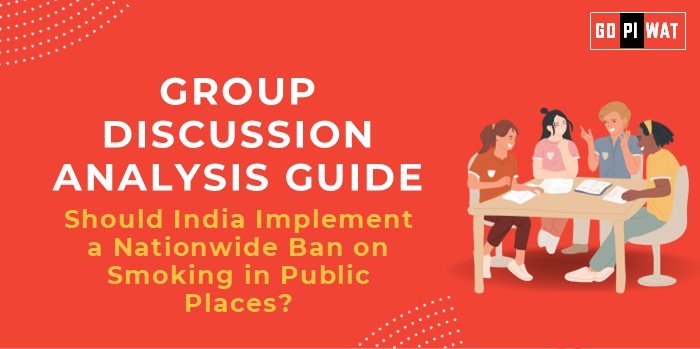📋 Group Discussion Analysis Guide: Should India Implement a Nationwide Ban on Smoking in Public Places?
🌐 Introduction to the Topic
- 💡 Opening Context: Smoking in public places is a contentious issue that balances public health concerns with individual freedoms. Globally, countries like the UK, Australia, and Singapore enforce strict smoking bans to protect public health.
- 📜 Background: India has implemented partial smoking bans since the Cigarettes and Other Tobacco Products Act (COTPA), 2003. However, enforcing these bans effectively remains a challenge, leading to debates about a nationwide prohibition.
📊 Quick Facts and Key Statistics
- ⚰️ Tobacco-Related Deaths: 1.35 million annually in India (WHO, 2023) – highlights the urgency of addressing smoking.
- 💸 Economic Burden: ₹1.77 lakh crore spent annually on tobacco-related illnesses (Public Health Foundation of India).
- 🌍 Global Perspective: Over 30 countries, including the UK and New Zealand, enforce comprehensive public smoking bans.
- 📜 Current Ban Coverage: Smoking prohibited in designated public areas like hospitals and educational institutions under COTPA.
- 📊 Public Opinion: 70% of Indians support stricter smoking laws (Tobacco Control Journal, 2023).
👥 Stakeholders and Their Roles
- 🏛️ Government Agencies: Enforce regulations, create awareness campaigns, and provide healthcare services.
- 🏭 Tobacco Industry: Key opposition due to revenue concerns; demands alternatives like designated smoking zones.
- 👥 Citizens: Majority supports bans for health benefits but faces potential pushback from smokers.
- 🌐 NGOs and Health Experts: Advocate for stricter laws and support de-addiction programs.
- 🏨 Businesses: Particularly hospitality and tourism sectors that could be impacted by smoking bans.
🏆 Achievements and Challenges
✨ Achievements
- 🏥 Public Health Initiatives: Reduction in smoking prevalence among adults (28% in 2010 to 23% in 2020).
- 📜 Legislation Impact: COTPA’s implementation has seen smoking bans in schools, hospitals, and transport hubs.
- 📺 Awareness Campaigns: Effective media campaigns have reduced tobacco consumption in younger demographics.
⚠️ Challenges
- 🔍 Enforcement Issues: Non-compliance in rural and urban areas due to weak monitoring.
- 💸 Economic Concerns: Impact on tobacco farmers and allied industries.
- 🛑 Cultural Resistance: Tobacco usage is ingrained in certain social practices.
🌍 Global Comparisons
- 🇦🇺 Success Example: Australia’s plain packaging laws led to a 12.8% drop in smoking rates within a decade.
- 🇺🇸 Struggles: The USA faced challenges balancing individual rights and public health, requiring incremental policy shifts.
📚 Case Study
- 🏞️ Kerala: Successfully enforced smoking bans in public spaces, showcasing better health outcomes and compliance rates.
💬 Structured Arguments for Discussion
- 💪 Supporting Stance: “A nationwide smoking ban will significantly reduce tobacco-related deaths and economic burdens.”
- ⚖️ Opposing Stance: “A nationwide ban infringes on personal freedoms and may create enforcement challenges.”
- 🤝 Balanced Perspective: “While a smoking ban benefits public health, implementation must balance health priorities with economic and social concerns.”
📚 Effective Discussion Approaches
- 💡 Opening Approaches:
- 📊 Highlight economic burden: “With ₹1.77 lakh crore spent on tobacco-related diseases annually, is smoking truly a personal choice?”
- 📚 Use a case study: “Kerala’s success in enforcing public smoking bans presents a roadmap for national implementation.”
- 🤔 Counter-Argument Handling:
“While a ban could impact tobacco farmers, government support for crop diversification can mitigate economic losses.”
🔎 Strategic Analysis (SWOT)
- 💪 Strengths: Health benefits, public support, global benchmarking.
- 🛑 Weaknesses: Enforcement gaps, resistance from stakeholders.
- 🌟 Opportunities: Public-private partnerships for awareness and alternatives.
- ⚠️ Threats: Economic losses, potential black-market growth.
🎓 Connecting with B-School Applications
- 📊 Real-World Applications: Discuss public policy implementation, healthcare economics, and CSR initiatives in tobacco alternatives.
- ❓ Sample Interview Questions:
- 💡 “Should public health take precedence over individual rights in policymaking?”
- 🌍 “How can India balance public health concerns with the economic impact of tobacco bans?”
- 📝 Insights for B-School Students: Explore intersections of business ethics, public health policies, and economic implications.


